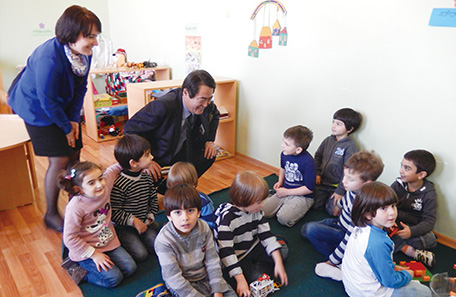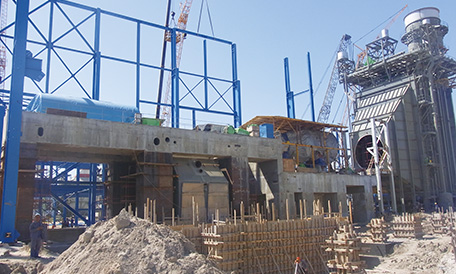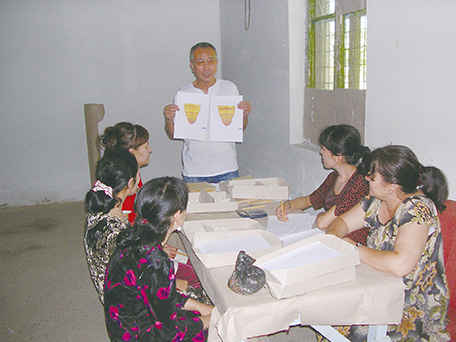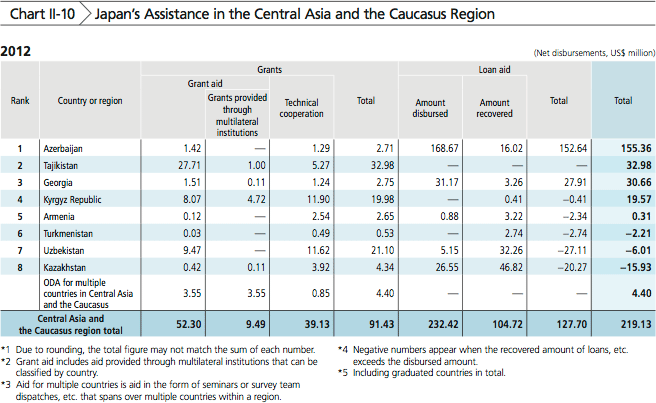Japan's Official Development Assistance White Paper 2013
3. Central Asia and the Caucasus
Central Asia and Caucasus regions are politically and geographically important areas, since they are surrounded by Russia, China, South Asia, the Middle East, and Europe. With their large abundance of energy and mineral resources such as oil, natural gas, uranium, and rare metals, the regions are also strategically important to Japan, which has been promoting resource and energy diplomacy aiming to diversify resource supply countries. For this reason, the stability and development of these regions are important for the stability and development of the Eurasia region as a whole including Japan. From this perspective, Japan provides support for nation-building conductive to long-term stability and sustainable development in the regions, with a view to establishing universal values, including human rights, democracy, market economy, and the rule of law, while taking into consideration a broad regional perspective which covers Afghanistan, Pakistan, and other regions that border Central Asia.

Parliamentary Vice-Minister for Foreign Affairs Takao Makino and children of a kindergarten in Tbilisi City, Georgia, which was renovated through the support of the Grant Assistance for Grass-Roots Human Security Projects.
<Japan’s Efforts>
In order to facilitate the transition from a planned economy to a market economy and economic development, Japan has conducted a diverse range of assistance activities in, such areas as improvement of legal systems, rebuilding of health and medical care and other aspects of social development, improvement of the infrastructure for economic development, and human resource development for the transition to a market economy. For example, Japan Centers* in Uzbekistan and the Kyrgyz Republic contribute to human resource development that can respond to the transition to a market economy by providing business courses and other activities based on Japan’s experiences.
Some of the world–class oil fields are found in the Caspian Sea coast of Kazakhstan and Azerbaijan. Japanese companies also have interests. The stability and economic development of the region are important for stabilizing the international energy market as well as for securing energy resources. Japan provides assistance to the region, including support for the improvement of public services, human resources, and infrastructure like power plants.
Japan established a framework of the “Central Asia plus Japan” Dialogue in 2004 focusing on the promotion of regional cooperation, and has conducted dialogue including foreign ministers’ meeting and cooperation at a variety of levels. The fourth foreign ministers’ meeting in the framework of “Central Asia plus Japan” was held in Tokyo in November 2012, commemorating 20th anniversary of the establishment of diplomatic relations between Japan and Central Asian countries.

Shimal gas combined-cycle power plant in Azerbaijan (second unit construction project).
Glossary
- *The Japan Center
- There are ten Japan Centers in nine countries which aim to develop human resources who will support the transition to market-oriented economies in countries with transition economies in Central Asia and the Indochina region. They serve as a venue to facilitate personal contacts between Japan and these countries, and provide a fine example of the visibility of Japanese aid. At present eight centers in seven countries are operated as JICA projects (two centers for which JICA projects are completed are also continuing their operations). Their main activities include provision of business courses and Japanese language courses, and promotion of mutual understanding.
●Uzbekistan
Technical Cooperation Project for Promotion of the Silk-Road Sericulture Industry in Uzbekistan—Developing a Technical Transfer Model to Increase Sideline Income of Remote Villages
JICA Partnership Program (Partner Type) (March 2013 - Ongoing)
Being a major transit point on the Silk Road, Uzbekistan traditionally had a prosperous silk industry. However, following the collapse of the Soviet Union, the regional economy suffered badly, and the traditional silk industry fell into decline. Due to aging and poorly maintained machinery and technological stagnation, the country is no longer able to produce internationally competitive silk in quality and quantity. This has resulted in a rapid decline in the number of silk farmers and has put at risk the continuation of this traditional industry that once produced valued silk fabrics. In light of this, Tokyo University of Agriculture and Technology has been working since 2009 to develop a business model for improving the livelihoods of silk farmers as part of the JICA Partnership Program (Partner Type). The project supports farmers, including women, from 50 pilot farming households and their neighbors in Fergana Province in developing their silk cultivation skills, in cooperation with Uzbekistan’s national sericulture research institute.
Drawing on these experiences, the project began providing support in 2013 also in Khorezm Province, which is located in western Uzbekistan and is home to 28,000 silk farmers. The aim is to establish a self-supported system for producing silk worms for high quality cocoons and improve the livelihoods of farmers. It is anticipated that these efforts will help revitalize the silk farming community and enable stable production of high-quality silk. The project also aims to develop craft products using Uzbekistan’s traditional Atlas (“King of Silk”) fabric, which is made using a similar technique to that of Japanese Kasuri fabric. It is hoped that the production of these products will become a secondary business of silk farmers and that they will eventually be exported as silk products of the New Silk Road.
(As of August 2013)

Silk farming mentoring in Fergana Province (Photo: Tokyo University of Agriculture and Technology)
●Georgia
Establishment of Poultry Nursery in Dzevera Village of Gori District
Grant Assistance for Grassroots Projects (January 2012 - Ongoing)
Located 70 km northwest of Tbilisi, the capital of Georgia, Gori District sustained serious damage as a result of the bombings that occurred during the 2008 armed conflict over South Ossetia and Abkhazia. Consequently, many residents lost their houses and other property. Domestic refugees from South Ossetia are still forced to live in very economically difficult situations.
Within the Gori District there are approximately 600 impoverished small-scale farmers who make a living from poultry farming with a limited number of incubators. The majority of poultry farmers does not use incubators and therefore keeps hens to incubate the eggs. However, hatching rates are extremely low at approximately 30%. Poultry farmers must thus often buy chicks from sellers, which are very expensive, making it difficult for farmers to make a profit. Therefore, Japan provided assistance for improving the poultry nursery managed by the cooperative association of small-scale poultry farmers in Dzevera Village of Gori District. Under the project, a 510 m2 poultry shed capable of incubating eggs, raising chickens and producing feed was built on a 4,500 m2 site of the cooperative association. Japan also provided poultry farming equipment.
The project was undertaken in cooperation with Poland. Japan improved the poultry nursery facility while Poland oversaw the development of processing infrastructure. This cooperation facilitated the development of an environment where small-scale farmers of Gori District are able to distribute their chicken more efficiently. Consequently, in the period between April 2012 and March 2013, 30,000 chicks were hatched, resulting in a $400 additional annual income for each of the 600 small-scale poultry farmers in Gori District.
(As of August 2013)

Members of a cooperative association making feed for chicks (Photo: Heifer International)


